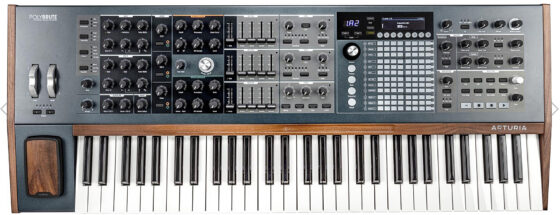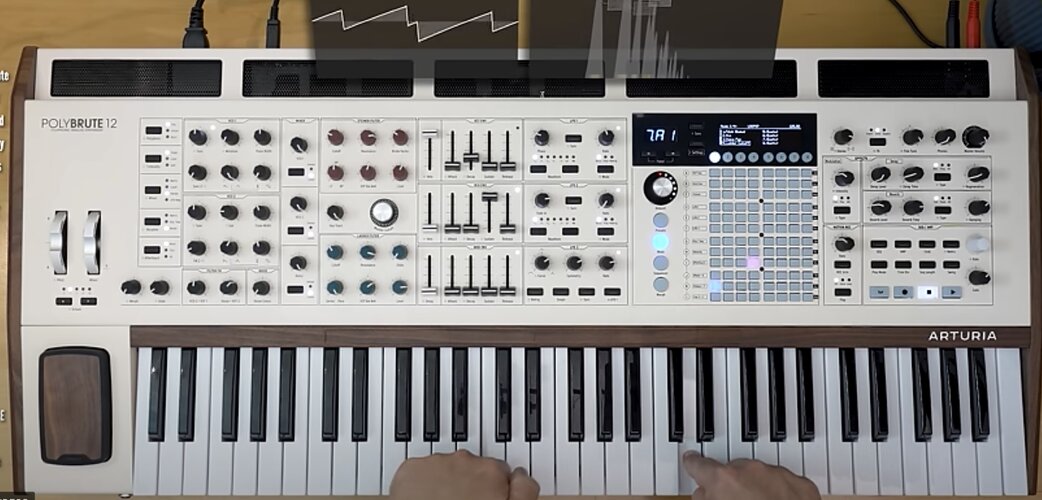Kommer PolyBrute kann jeden Standardsound erzeugen, den man kennt. PWM Bässe, Sawsequenzen, Noise mit Resonanz Geticker usw. In brav und in böser und in ganz böse. Kommt trocken einfach gut und klingt leicht anders vom Charakter her als von Moog, Oberheim, Roland usw. gewohnt.
Warum man das in Videos nicht hört? Ganz einfach, weil das in den Presets Null abgedeckt ist und anscheinend alle, die auf YT rumjubeln zu doof sind ein paar einfache Sounds selbst zu erstellen. Ich hör bloß die immer wieder gleichen im Reverb absaufenden Weichpads ala Vangelis. Macht halt schnell eindruck, wenn man da bisschen am Mastecutoff dreht.
Bisschen abseits vom üblichen gibts hier. Aber leider auch viel Weichspüli dabei und immer viel zuviel FX. Aber man kann z.T. erahnen, daß da wesentlich mehr geht. Die Kunst beim Soundschrauben ist auch, daß man mal was weglässt.
Danke, genau das wollt ich mal hören, denke ich genauso.
Ich bin hier wirklich sehr brav, wahrscheinlich, weil ich hier nicht so viel Scheisse lesen muss, aber außerhalb äußerst aggressiv unterwegs.
Es ist gerade meine kleine Freude stress anzufangen, um dämliche Kommentare abzustrafen, aber in ritterlicher Passion.
Brauch der Mensch auch mal und kann ja nicht sein, dass sich purifizierter Müll ständig wiederholt. Irgendein Blödsinn wird immer nachgeplappert.
Ich hab den polybrute ja selbst, den 6er und weiß für welche standards ich ihn gut finde.
Ansonsten kann ja jeder standardsynth standardsounds. Ist halt immer die Frage ob man da mitgeht.
Das Video ist eines meiner Lieblingsvideos vom 6er und eines der ersten.
Ich frag mich ob sich ein upgrade lohnt zum 12er.
Erstmal frag ich mich ob die identisch klingen, wovon ich in diesem Fall 1:1 ausgehe.
Dann frag ich mich eben, wie gut bei diesen trockenen und/oder standardsounds die neuen Tastaturfunktionen kommen. Man hört in den demos ja schon, dass es super schön zischt und fizzlt. Ich habe versuche mit velocity und teilweise aftertouch gemacht, ist aber lange nicht das Selbe.
Außerdem verliert der 6er schnell die puste, was stimmen angehen.
Lohnt sich das? Frag ich mich.
Leider kann ich ihn erstmal nicht bestellen und das macht auch keinen sinn solange der 6er da ist.
Das der ambientartige sounds gut macht, weiß nun jeder.
Ich hab gestern einen typischen "wc olo garb" auf dem polybrute gebaut. Ist halt nicht so harsch, aber hat sehr gut geklappt.
Der polybrute klingt sehr anders, als die von dir genannten. Vom grad her so anders wie ein ax80 oder so. Liegt auch an den Filtern.
Der polybrute ist seitig und eher dunkel.
Wenn ich lese, der polybrute klingt digital oder wie ein va, muss ich aus reflex reintreten.
Ist ja auch ne Aussage, für die man sich anscheinend nicht schämen brauch. Genau wie, dass der muse 0815, beliebig und charakterlos klingt. Das sind keine Meinungen.
Blödsinn.
Der pb kling zwar anders, aber hat einige starke analoge traits, die gut zu hören sind. Das was man eben davon heute so erwartet und sich in den ambitionen neuer analoger polysynth widerspiegelt.
Sieht wohl so aus, dass die wenigsten social media figuren programmieren wollen oder können. Video muss nach dem Auspacken auch schnell raus. Am besten das antesten schon aufnehmen.



